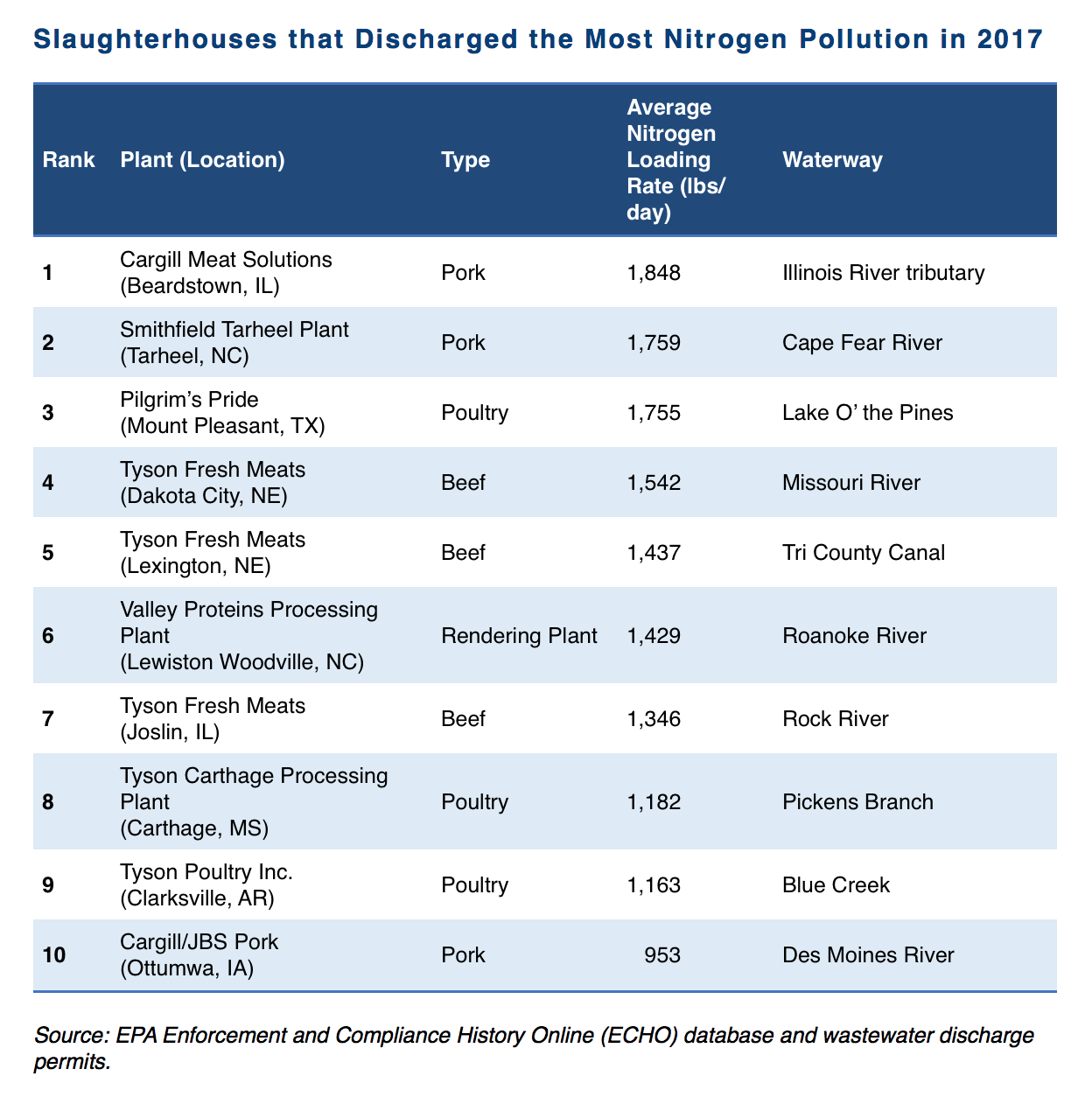Brian Zabcik
Media contact: Tom Pelton, Environmental Integrity Project, [email protected]
AUSTIN — Three-quarters of large U.S. meat processing plants that discharge their wastewater directly into streams and rivers violated their pollution control permits over the last two years, with some dumping as much nitrogen pollution as small cities — and facing little or no enforcement. Texas is home to the third-worst polluter in the country — the Pilgrims Pride poultry processing plant in Mount Pleasant.
The nonprofit Environmental Integrity Project (EIP) examined EPA records for 98 large meat-processing plants that released more than 250,000 gallons per day into waterways from January 2016 through June 2018 and found that 74 of the plants had exceeded their permit limits for nitrogen, fecal bacteria, or other pollutants at least once. More than half of the plants (50 of 98) had five violations, and a third (32 of 98) had at least 10 violations, according to the EPA data.
EIP’s new report, “Water Pollution from Slaughterhouses,” with research from Earthjustice, also discovered that 60 of the 98 plants release their wastewater to rivers, streams, and other waterways that are impaired because of the main pollutants found in slaughterhouse wastewater: bacteria, pathogens, nutrients, and other oxygen-depleting substances. Click here to read the full report.
“This water pollution is really an environmental justice issue, because many of these slaughterhouses are owned by wealthy international companies, and they are contaminating the rivers and drinking water supplies of rural, often lower-income, minority communities,” said Eric Schaeffer, Executive Director of the Environmental Integrity Project.
“State environmental agencies need to start cracking down on and penalizing these flagrant violations of the federal Clean Water Act,” said Schaeffer, former Director of Civil Enforcement at EPA. “And EPA needs to step in and set stronger national water pollution standards for meat processing plants.”
Peter Lehner, senior attorney at Earthjustice, said: “Slaughterhouses are another dirty link in the highly polluting industrial meat production chain. From polluted runoff from over-fertilized fields growing animal feed, to often-leaking manure lagoons and contaminated runoff at concentrated animal feeding operations, and to industrial slaughterhouses, the way most of our meat is now produced impairs our drinking water and public health. We need to clean up every stage.”
The report ranks the worst polluters in terms of total nitrogen pollution (which fuels excessive algae growth and creates fish-killing low-oxygen “dead zones”). According to the report, the Pilgrims Pride poultry slaughterhouse in Mount Pleasant discharged 1,755 pounds of nitrogen a day, on average, into Lake O’ the Pines last year, making it the third-worst polluter in the country.
“Texas love our barbecue — but nobody ordered a side of water pollution along with our meat,” said Brian Zabcik, Clean Water Advocate at Environment Texas. “The Texas Commission on Environmental Quality needs to issue stronger water pollution control permits for the slaughterhouses in East Texas and elsewhere — and then enforce them, so they stop contaminating our waterways.”
For a list of the worst polluters, see chart at bottom. For a detailed list of all 98 slaughterhouses studied, click here.
EIP’s research found that many of the plants that are not violating their permits are actually discharging more pollution than those breaking the law by failing to comply. In such cases, EPA and state agencies are setting permit limits that allow the discharge of far too much pollution to protect waterways for swimming, fishing or other public uses.
Sixty-five of the 98 meat processing plants that the Environmental Integrity Project examined slaughter chickens, 15 process beef; 9, hogs; and the rest, other meat. The results detailed in the “Water Pollution from Slaughterhouses” report include:
The report examines case studies in Delaware, Florida, and Illinois, where local residents have suffered from contaminated drinking water wells, fish kills, tainted rivers and other severe impacts of slaughterhouse pollution.

The EIP report notes that not all of the slaughterhouses are poorly run or in violation of their permits. The most polluting plants in EIP’s study released about thirty times more nitrogen per gallon than the cleanest plants.
“This a sign that these dirty slaughterhouses can improve substantially simply by installing wastewater treatment systems already used by their competitors,” said Eric Schaeffer of EIP. “Requiring these improvements across the U.S. would level the playing field for the industry, while improving protections for waterways and public health.”
The study found that state regulators – often burdened by budget cuts and limited staffing – are often behind in developing cleanup plans for impaired waterways as required by the federal Clean Water Act. Lacking cleanup plans (also called Total Maximum Daily Loads or “TMDL’s”), state regulators are not setting strong enough pollution limits in the permits that they issue to slaughterhouses.
In 40 of the 98 cases EIP examined, the states have not yet established cleanup plans for local waterways to reduce pollution from slaughterhouses and other sources by the amounts needed to restore the rivers and streams to health.
POLICY RECOMMENDATIONS:
The report concludes that the state and federal governments should do more to reduce water pollution from the slaughterhouse industry by:
1) Stepping up both state and federal enforcement of permit violations by meat processing plants;
2) Strengthening outdated EPA standards for water pollution from meat processing plants nationally (which have not been updated since 2004) with tighter limits for nitrogen, bacteria, and other pollutants, along with better monitoring;
3) Tightening up state pollution control permits to reduce discharges of wastewater to rivers, lakes, and streams that are so polluted that they are impaired for public use;
4) Prohibiting irresponsible disposal methods, such as spraying waste onto farm fields that are close to homes, whose drinking water wells can be contaminated.
###
The Environmental Integrity Project is a nonprofit, nonpartisan organization, based in Washington D.C., that protects public health and the environment by investigating polluters, holding them accountable under the law, and strengthening public policy.
Environment Texas is a nonprofit advocate for clean air, clean water and open spaces.
